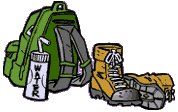
Kit Guide
Essential Clothing
WEAR CLOTHING THAT TAKES
ACCOUNT OF ANTICIPATED CONDITIONS.
BE PREPARED FOR CHANGING CONDITIONS.
1. Boots should be comfortable and robust They should give support and protection.
All boots require protection -waxing or spraying.
2. Trousers - most loose fitting trousers
will do. Leggings are also good.
Denim is not suitable as it takes a long
time to dry.
3. Over-trousers - for very wet conditions.
4. Lightweight shirt, blouse or T-shirt.
5. Pullover or Jumper - 2 thin layers are better than 1 thick layer.
6. Top Garment - Anorak, cagool, fleece or padded shirt - according to the anticipated conditions - But always be prepared for rain and carry a waterproof.
7. Hat - always carry some kind of headwear.
8. Gloves - essential in the winter.
9. Gaiters - not essential - but are recommended in wet and muddy conditions
Kit - Essential Items
1. Rucksack - a small day pack with side pockets is ideal. Use a liner to keep the contents dry - rucksacks are not waterproof.
2. Rations - carry enough for a lunch
and 2 coffee breaks. A hot drink in
a flask is advisable during winter
walks and always have sufficient
water. Carry some chocolate in your jacket pocket for energy.
3. Dry Bag - bring a change of clothes
to be left on the bus.
4. Ground Seat - A padded or insulated square or something to keep you off
the ground to protect you from the
cold and wet when sitting.
Optional Items
1. Walking Stick - can be useful on hills.
2. Compass.
3. O.S. Map.
4. First Aid Kit - a small personal first aid kit should be carried
5. Torch - especially in Winter
6. Whistle
